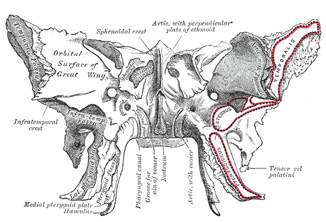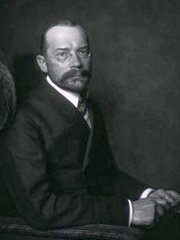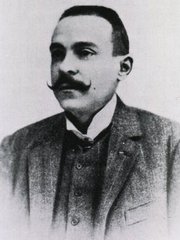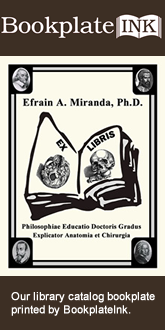
Medical Terminology Daily (MTD) is a blog sponsored by Clinical Anatomy Associates, Inc. as a service to the medical community. We post anatomical, medical or surgical terms, their meaning and usage, as well as biographical notes on anatomists, surgeons, and researchers through the ages. Be warned that some of the images used depict human anatomical specimens.
You are welcome to submit questions and suggestions using our "Contact Us" form. The information on this blog follows the terms on our "Privacy and Security Statement" and cannot be construed as medical guidance or instructions for treatment.
We have 366 guests online

Georg Eduard Von Rindfleisch
(1836 – 1908)
German pathologist and histologist of Bavarian nobility ancestry. Rindfleisch studied medicine in Würzburg, Berlin, and Heidelberg, earning his MD in 1859 with the thesis “De Vasorum Genesi” (on the generation of vessels) under the tutelage of Rudolf Virchow (1821 - 1902). He then continued as a assistant to Virchow in a newly founded institute in Berlin. He then moved to Breslau in 1861 as an assistant to Rudolf Heidenhain (1834–1897), becoming a professor of pathological anatomy. In 1865 he became full professor in Bonn and in 1874 in Würzburg, where a new pathological institute was built according to his design (completed in 1878), where he worked until his retirement in 1906.
He was the first to describe the inflammatory background of multiple sclerosis in 1863, when he noted that demyelinated lesions have in their center small vessels that are surrounded by a leukocyte inflammatory infiltrate.
After extensive investigations, he suspected an infectious origin of tuberculosis - even before Robert Koch's detection of the tuberculosis bacillus in 1892. Rindfleisch 's special achievement is the description of the morphologically conspicuous macrophages in typhoid inflammation. His distinction between myocardial infarction and myocarditis in 1890 is also of lasting importance.
Associated eponyms
"Rindfleisch's folds": Usually a single semilunar fold of the serous surface of the pericardium around the origin of the aorta. Also known as the plica semilunaris aortæ.
"Rindfleisch's cells": Historical (and obsolete) name for eosinophilic leukocytes.
Personal note: G. Rindfleisch’s book “Traité D' Histologie Pathologique” 2nd edition (1873) is now part of my library. This book was translated from German to French by Dr. Frédéric Gross (1844-1927) , Associate Professor of the Medicine Faculty in Nancy, France. The book is dedicated to Dr. Theodore Billroth (1829-1894), an important surgeon whose pioneering work on subtotal gastrectomies paved the way for today’s robotic bariatric surgery. Dr. Miranda.
Sources:
1. "Stedmans Medical Eponyms" Forbis, P.; Bartolucci, SL; 1998 Williams and Wilkins
2. "Rindfleisch, Georg Eduard von (bayerischer Adel?)" Deutsche Biographie
3. "The pathology of multiple sclerosis and its evolution" Lassmann H. (1999) Philos Trans R Soc Lond B Biol Sci. 354 (1390): 1635–40.
4. “Traité D' Histologie Pathologique” G.E.
Rindfleisch 2nd Ed (1873) Ballieres et Fils. Paris, Translated by F Gross
"Clinical Anatomy Associates, Inc., and the contributors of "Medical Terminology Daily" wish to thank all individuals who donate their bodies and tissues for the advancement of education and research”.
Click here for more information
- Details

Anterior view of the sphenoid bone
Both these root terms have their origin from the Greek [πτέρυγα] (ptéryga) and mean "wing".
In human anatomy the most common use of this root term is in the word [pterygoid]. Since the suffix [-oid] means "similar to", the word pterygoid means "similar to a wing", or "wing-like".
On the inferior aspect of the sphenoid bone (os sphenoidale) there are two very thin bat-wing-like bony appendages that are called the lateral and medial pterygoid plates. The medial pterygoid plate has a hook-like bony appendage called the hamulus (Latin: little hook).
Related to the pterygoid plates are the lateral and medial pterygoid muscles, both these muscles aid inthe process of mastication.
The root term [pter-] can be found in words such as [pterodactyl] meaning "winged finger", it refers to a phrehistoric winged animal; [pteranodon], and [pterosaurus].
Sources:
1 "Tratado de Anatomia Humana" Testut et Latarjet 8 Ed. 1931 Salvat Editores, Spain
2. "Anatomy of the Human Body" Henry Gray 1918. Philadelphia: Lea & Febiger
Image in the public domain modified by CAA, Inc. Original image courtesy of bartleby.com
Note: Google Translate includes the symbol (?). Clicking on it will allow you to hear the pronunciation of the word.
- Details
The sinuatrial node, is also known as the "sinoatrial node", "SA node" or by its eponym, the "node of Keith and Flack". It is the initial component of the conduction system of the heart.
It is a small nodule of cardiac muscle tissue, somewhat horseshoe-shaped that is found at the junction of the superior vena cava and the right atrium. Because of the inherent automaticity and rhythmical contractions of the SA node, it acts as the main pacemaker of the heart, being the base for normal heart beat, also known as "sinus rythm"
It receives blood supply from the SA node artery, usually the first or second branch that arises off the right coronary artery. The SA node artery is a long vessel that passes between the right atrium and the ascending aorta on its way to the SA node.
The SA node receives innervation from both sympathetic and parasympathetic nerves. The parasympathetic innervation is by way of the vagus nerve, the Xthcranial nerve. The sympathetic innervation is by way of the cardiac nerves, a plexus that has its origin in the ventral ramiof the first four thoracic spinal nerves (T1-T4).
The SA node was discovered in 1906 by Martin W. Flack (1882-1931) and Arthur Keith (1866-1955). They named it originally the sinoauricular node.
Click on the image for a larger version. Image modified from the original: "3D Human Anatomy: Regional Edition DVD-ROM." Courtesy of Primal Pictures
- Details
This article is part of the series "A Moment in History" where we honor those who have contributed to the growth of medical knowledge in the areas of anatomy, medicine, surgery, and medical research.

Wilhelm His Jr.
Wilhelm His Jr. (1863-1934). Also known as Wilhelm His the Younger, was born in Switzerland in the city of Basel. His father was a well-known and famous anatomist by the same name who worked at the University of Basel. Wilhelm His Jr. studied in several universities, including Leipzig, Strasbourg, Bern, and Geneva. He received his medical degree from the University of Leipzig in 1889.
Although not an anatomist, his 1893 single and most brilliant contribution to the eventual understanding of the conduction system of the heart was the discovery and description of a muscular bundle that connected the atrial septum with the ventricular septum. Until that moment it was known that no muscles crossed from the atria to the ventricles, leading anatomists and physiologists to wonder how does the heart contract.
In his article His states "after long search I have succeeded in finding a muscle bundle which unites the auricular and ventricular septal walls, and which, up to now, has escaped observation because of incomplete exposure, for it is visible in its entire extent only when the septa are cut exactly in their longitudinal direction".
What is interesting is that His not only found the bundle that today honors his name, but he included in that description the atrioventricular node, the actual structure that crosses the atrioventricular connective tissue barrier known as the "skeleton of the heart". The AV node was later to be clearly identified and researched by Sunao Tawara (1873 - 1952).
Dr. His continued his research on gout and joint diseases. He became a German citizen and joined the German army as a consulting physician. He retired in 1932 and died in 1934.
Although Wilhelm His Jr. did not discover or described the esophagogastric angle, in 1906 JD Cunningham started calling this angle the "Angle of His" in honor of Wilhelm His Jr. This eponym has stayed with us until today.
Sources:
1. "Wilhelm His Jr." JAMA. 1964;187(6):453-454
2. "His, Jr., W.: The Activity of the Embryonic Human Heart and Its Significance for the Understanding of the Heart Movement in the Adult" Arb Med Klin Leipzig, pp 14-49, 1893; Bast, TH,Gardner, WD trans: J Hist Med 4:289-318, 1949
3. "Wilhelm His, Jr. and the Bundle of His" Bast, TH, Gardner, WD J Hist Med All Sci; 1949; 4, (2) 170 -187
4. Firkin BG (1996) Dictionary of medical eponyms.London: Parthenon Publishing Group, 181
Original image in the public domain, courtesy of the National Library of Medicine.
- Details
The [sphincter of Oddi] is a complex system of smooth muscles that controls flow of bile and pancreatic juice into the duodenum. Although known by its eponym, this structure has the anatomical name of "sphincter of the hepatopancreatic ampulla". Although described previously by others, it was Ruggero Oddi (1864-1913) who described not only its structure, but also its function.
The hepatopancreatic ampulla or "ampulla of Vater" is a dilation found at the conjunction and end of the common bile duct and pancreatic duct. The presence of the hepatopancreatic ampulla creates a nipple-like elevation of the duodenal mucosa called the "duodenal papilla".
The sphincter of Oddi has several components:
- Sphincter papillae: This portion of the sphincter surrounds the papillary and intramural portion of the hepatopancreatic ampulla
- Sphincter choledochus: This portion of the sphincter surrounds the most distal portion of the common bile duct. It must be noted that this is the narrowest portion of the common bile duct, allowing for potential lodging of bile stones, cause for choledocholithiasis
- Sphincter pancreaticus: This portion of the sphincter surrounds the most distal portion of the pancreatic duct and prevents reflux of bile from the hepatopancreatic ampulla to the pancreatic duct.
The duodenal muscular layer parts to allow passage of the complex formed by the hepatopancreatic ampulla and the sphincter of Oddi, creating a window called the "choledochal window". Longitudinal fibers from the duodenal muscularis externa pass and join to the sphincter of Oddi.
- Details
This is a root term of Greek origin. In both presentations [-chol-] or [-chole-] it means "bile" or "gall". The English word "gall" is of Anglosaxon origin and means "bile", referring to its yellowish-green color. The word [bile] is of Latin origin, from [bilis].
These root terms are used in many medical words, such as:
- cholecystitis: [cyst] means "sac" or "bladder", [itis] means "inflammation" or "infection". Gallbladder inflammation
- cholecystectomy: [cyst] means "sac" or "bladder", [ectomy] means "removal". Gallbladder removal
- cholangiogram: [angi] means "vessel", [(o)gram] means "examination". Examination of a bile vessel
- choledocholithiasis: Condition of stones in the bile duct. Click on the link for more information
- cholera: The suffix [-era] is "flow" or "discharge". The term refers to the constant vomiting of bile in patients afflicted with this disease. This term has been heatedly discussed and this is but one of the theories as to the etymology of the word.
In the early days of physiology, yellow bile was considered one of the "four humors" that made up human personality, temperament, and health. A person with an excess of yellow bile would be considered bad tempered, angry, or "choleric". Observe how the root term [chole] also is found in the word "choleric".
Sources:
1. "The Language of Medicine" John H. Dirckx Pub: Harper & Row 1976
2. "Medical Meanings" Haubrich, William S. Am Coll Phys Philadelphia 1997
3. "The origin of Medical Terms" Skinner, AH, 1970
- Details
This article is part of the series "A Moment in History" where we honor those who have contributed to the growth of medical knowledge in the areas of anatomy, medicine, surgery, and medical research.

Ruggero Oddi
Ruggero Oddi (1864-1913). Anatomist and physician, his complete name was Ruggero Ferdinando Antonio Giuseppe Vincenzo Oddi Pampaglini, born on July 20, 1814 in the city of Perugia, Italy. He studied medicine in the University of Perugia, where he had a keen interest in anatomy and physiology, graduation with a medical degree in 1889. In 1887, as a fourth year medical student Oddi published a paper that would make his name eponymically tied to the sphincter found around the hepatopancreatic ampulla; what today is known as the "sphincter of Oddi". His paper was entitled "Di una Speciale Disposizione a Sfintere allo Sbocco del Coledoco" (On a Special Sphincteric Arrangement at the Outlet of the Common Bile Duct).
Although the circular muscle of the sphincter of Oddi had already been described by Glisson in 1681, Oddi was the one who did a complete anatomical and physiological study of this structure uncovering the fact that it was indeed a sphincter. He continued his studies on the hepatobiliary sphincter until 1894, when he moved to Congo and later back to Belgium.
Because of his inclination towards metaphysical studies, Oddi started experimenting with drugs on himself and became addicted.
His later life was surrounded by scandal and controversy, because of drug abuse and fiscal mismanagement of University funds. Oddi died in poverty in 1913 and his site of burial is unknown.
Sources:
1. "Ruggero Ferdinando Antonio Guiseppe Vincenzo Oddi" Lukas, M, et al. World J Surg (2007) 31:2260–2265
2. "Ruggero Oddi; To commemorate the centennial of his original article--"Di unaspeciale disposizione a sfintere allo sbocco del coledoco" Ono, K; Hada, R. Jap J Surg, VOL. 18, No. 4 pp. 373-375, 1988
3. "Ruggero Oddi: 120 years after the description of the eponymous sphincter: A story to be remembered" Capodicasa, E. J Gastroent Hepat 23 (2008) 1200–1203
4. "Oddi: The Paradox of the Man and the Sphincter" Modlin, IM; Ahlman, H. Arch Surg 129 (1994) May 550-557
Original image in the public domain, courtesy of the National Library of Medicine.



